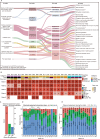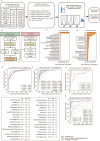iDIA-QC: AI-empowered data-independent acquisition mass spectrometry-based quality control
- PMID: 39837863
- PMCID: PMC11751188
- DOI: 10.1038/s41467-024-54871-1
iDIA-QC: AI-empowered data-independent acquisition mass spectrometry-based quality control
Abstract
Quality control (QC) in mass spectrometry (MS)-based proteomics is mainly based on data-dependent acquisition (DDA) analysis of standard samples. Here, we collect 2754 files acquired by data independent acquisition (DIA) and paired 2638 DDA files from mouse liver digests using 21 mass spectrometers across nine laboratories over 31 months. Our data demonstrate that DIA-based LC-MS/MS-related consensus QC metrics exhibit higher sensitivity compared to DDA-based QC metrics in detecting changes in LC-MS status. We then prioritize 15 metrics and invite 21 experts to manually assess the quality of 2754 DIA files based on those metrics. We develop an AI model for DIA-based QC using 2110 training files. It achieves AUCs of 0.91 (LC) and 0.97 (MS) in the first validation dataset (n = 528), and 0.78 (LC) and 0.94 (MS) in an independent validation dataset (n = 116). Finally, we develop an offline software called iDIA-QC for convenient adoption of this methodology.
© 2024. The Author(s).
Conflict of interest statement
Competing interests: T.G. and Y. Zhu are shareholders of Westlake Omics Biotechnology Co., Ltd. Three patents related to iDIA-QC technologies have been filed. Two have been granted, with the numbers CN 114858958 B and CN 116106464 B, while the third is currently pending, with the application number CN 202210783026.2. Y.L., Z.N. and Y.L. are employees of Westlake Omics Inc. H.F. and M.C. are employees of Shanghai Luming Biological Technology Inc. Q.F. and J.T. are employees of Shanghai Applied Protein Technology co. ltd. C.C., X.L., X.L. and F.K. were employees of SCIEX China during this project. Z.G., Y. Q. and T.T. are employees of Thermo Fisher Scientific China while R.W., X.D., L.M. and M.W. are employees of Bruker Daltonics China. The remaining authors declare no competing interests.
Figures






Similar articles
-
Standard operating procedure combined with comprehensive quality control system for multiple LC-MS platforms urinary proteomics.Nat Commun. 2025 Jan 26;16(1):1051. doi: 10.1038/s41467-025-56337-4. Nat Commun. 2025. PMID: 39865094 Free PMC article.
-
Statistical Assessment of QC Metrics on Raw LC-MS/MS Data.Methods Mol Biol. 2017;1550:325-337. doi: 10.1007/978-1-4939-6747-6_22. Methods Mol Biol. 2017. PMID: 28188539
-
A comparative study of data-independent acquisition and data-dependent acquisition in liquid chromatography-mass spectrometry-based untargeted metabolomics analysis of Panax genus sample.Anal Bioanal Chem. 2025 Jun;417(14):3215-3228. doi: 10.1007/s00216-025-05861-9. Epub 2025 Apr 2. Anal Bioanal Chem. 2025. PMID: 40172670
-
Processing strategies and software solutions for data-independent acquisition in mass spectrometry.Proteomics. 2015 Mar;15(5-6):964-80. doi: 10.1002/pmic.201400323. Epub 2015 Feb 2. Proteomics. 2015. PMID: 25430050 Review.
-
LC-MSE, Multiplex MS/MS, Ion Mobility, and Label-Free Quantitation in Clinical Proteomics.Methods Mol Biol. 2017;1546:57-73. doi: 10.1007/978-1-4939-6730-8_4. Methods Mol Biol. 2017. PMID: 27896757 Review.
References
-
- Domon, B. & Aebersold, R. Options and considerations when selecting a quantitative proteomics strategy. Nat. Biotechnol.28, 710–721 (2010). - PubMed
-
- Xiao, Q. et al. High-throughput proteomics and AI for cancer biomarker discovery. Adv. Drug Deliv. Rev.176, 113844 (2021). - PubMed
-
- Aebersold, R. & Mann, M. Mass-spectrometric exploration of proteome structure and function. Nature537, 347–355 (2016). - PubMed
-
- Mann, M. Comparative analysis to guide quality improvements in proteomics. Nat. Methods6, 717–719 (2009). - PubMed
-
- Bittremieux, W. et al. Quality control in mass spectrometry-based proteomics. Mass Spectrom. Rev.37, 697–711 (2018). - PubMed
MeSH terms
LinkOut - more resources
Full Text Sources

